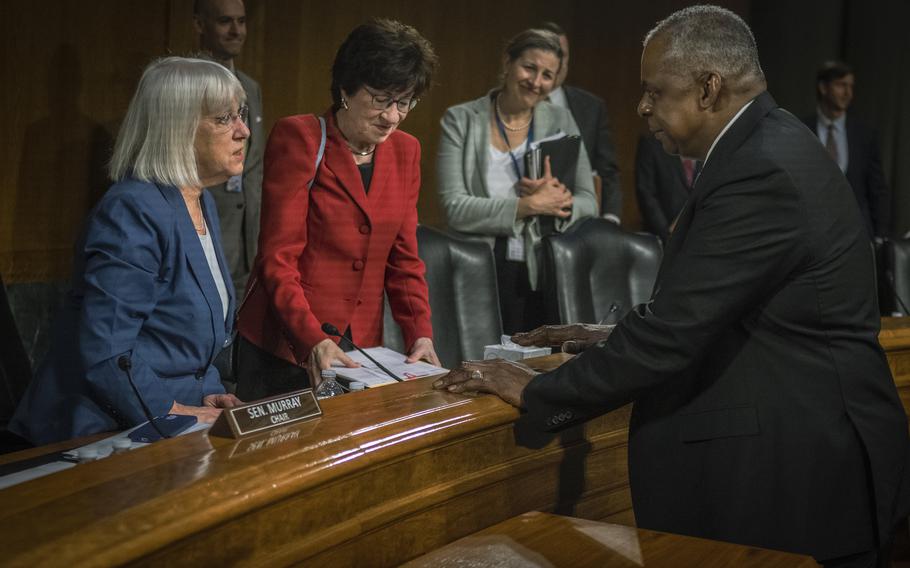
Defense Secretary Lloyd Austin speaks with Sens. Patty Murray, D-Wash., and Susan Collins, R-Maine, during a Senate Appropriations Committee hearing in May 2023. (Chad J. McNeeley/Department of Defense)
WASHINGTON — Senate appropriators on Wednesday criticized the proposed Defense Department budget for fiscal 2025 as too low to invest in future military technology and meet threats from an increasingly dangerous world.
The White House’s request for an $895 billion defense budget sticks to a spending cap mandated by law last year, but lawmakers on the Senate Appropriations Committee indicated they will attempt to find a way around it to boost the Pentagon’s coffers.
“We must be clear-eyed that this budget request would represent a real cut in funding for the Department of Defense,” said Sen. Susan Collins of Maine, the top Republican on the committee.
The proposed spending plan represents a 1% increase from the prior year and falls nearly $14 billion short of the $22.5 billion needed to cover rising fuel costs and other expenses, according to Collins.
Sen. Jon Tester of Montana, the Democratic chairman of the committee’s defense subpanel, said the military services and combatant commands have provided Congress with unfunded priorities lists that total more than $20 billion.
He also said the request for fiscal 2025, which begins Oct. 1, is $10 billion below the funding level that the Pentagon had planned for before congressional fighting over the debt limit imposed caps on federal spending.
“We need a bigger number,” Tester said during a hearing on the defense budget request. “If we’re going to invest in future technologies, this number has to be bigger.”
Defense Secretary Lloyd Austin said the Pentagon prioritized near-term readiness and support for service members over longer-term modernization investments, such as fifth- and sixth-generation aircraft, as a result of the budget cap.
“We had to make some tough, but responsible choices,” he told senators. “We decided not to invest in some modernization that would not deliver results before 2030, and we invested in our people and our families.”
Troops are set to receive a 4.5% pay raise under the budget request. Austin said the Defense Department would be able to make up for the 2025 funding shortfall in modernization if lawmakers ensure future budgets include meaningful growth.
Air Force Gen. Charles “CQ” Brown, the chairman of the Joint Chiefs of Staff, said a lack of additional financial support in the coming years would be felt operationally five to 10 years from now, but a leaner 2025 budget is not expected to make an impact today.
Still, senators said Wednesday that it is reckless to shortchange the Pentagon at a time when Russia is waging war in Ukraine, Iran and its proxies are fanning violence in the Middle East and China is growing its military budget.
China is planning a 7.2% spending increase on defense.
“If the world were becoming safer, then perhaps such a reduction could be absorbed with little risks to national security,” Collins said. “But unfortunately, that is not the world in which we live.”
Tester described the security climate as the most dangerous in his lifetime, comparing it to the tense confrontation between the U.S. and the Soviet Union during the Cuban Missile Crisis in the early 1960s.
“We need to understand what risk a lower budget creates for our military personnel, our operations around the globe and our modernization efforts,” he said. “We’ve got to get a budget done so the men and women in uniform supported by the civilians of the Department of Defense can go about their business of keeping America safe.”
Other lawmakers have also voiced support in recent weeks for circumventing the debt limit deal and giving the Pentagon more money.
Sen. Roger Wicker of Mississippi, the top Republican on the Senate Armed Services Committee, argued in an op-ed last month that the budget in its current form shrinks the Navy and Air Force, underfunds operations in the Indo-Pacific region by $11 billion and slashes $900 million from missile defense programs.
“Fortunately, Congress has the power of the purse and can demonstrate to the world that America still pursues peace through strength,” he wrote in The Hill.
Democrats are unlikely to agree to a deal that would raise the cap without also exceeding limitations on domestic spending.
Sen. Patty Murray of Washington, the Democratic chairwoman of the appropriations committee, agreed Wednesday that the defense budget was “inadequate” but said other federal agencies are also in need of more resources.
“As members talk about how we might increase investments to better meet our defense needs, we cannot ignore our needs here at home as well,” she said. “When it comes to additional resources above the caps, which the vice chair and others have mentioned, I’m going to insist on parity for non-defense spending.”